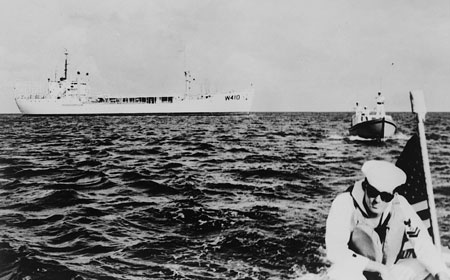
August 4, 1790 – President George Washington signed the Tariff Act that authorized the construction of ten vessels, referred to as “cutters,” to enforce federal tariff and trade laws and to prevent smuggling. Called the Revenue Cutter Service, the size and responsibilities of the organization expanded as the nation grew.
1837 – Congress authorized the President “to cause… public vessels… to cruise upon the coast, in the severe portion of the season… to afford such aid to distressed navigators as their circumstances and necessities may require; and such public vessels shall go to sea prepared fully to render such assistance.” (www.history.uscg.mil)
April 13, 1861 – The Revenue Cutter Harriet Lane fired the first shot from a naval vessel in the Civil War.
March 30, 1867 – The United States purchased Alaska and the revenue cutters Lincoln and Wayanda begin surveying the region.
1878 – The Posse Comitatus Act limited military involvement in civil law enforcement, leaving the Revenue Cutter Service as the only force consistently charged with federal law enforcement on the seas and U.S. waters.
March 3, 1905 – Congress authorized the Secretary of the Treasury to acquire a suitable site in the state of Maryland upon which to establish a depot for the Revenue Cutter Service. The site eventually became the Coast Guard Yard.
January 28, 1915 – President Woodrow Wilson signed the bill merging the Revenue Cutter Service and the Life-Saving Service, officially creating the Coast Guard. It was the only maritime service dedicated to saving life at sea and enforcing the nation’s maritime laws.
September 26, 1918 – A torpedo from a German submarine sunk the USCGC Tampa while on convoy duty. The dead included 111 Coast Guardsmen, four U.S. Navy men, and others. It was the single largest U.S. naval combat loss of the war.
1923 – The Coast Guard established an oceanographic unit at Harvard University charged with providing support and conducting research for the International Ice Patrol.
1939 – President Franklin Roosevelt ordered the transfer of the Lighthouse Service to the Coast Guard, putting it in charge of maritime navigation.
July 16, 1947 – Marine-inspection and navigation duties were permanently transferred to the Coast Guard, which was then responsible for almost all aspect of merchant-marine personnel and ship safety.
1967 – The Coast Guard was transferred to the Department of Transportation, adding responsibilities like economic traffic, migrant interdiction, and coping with hazardous cargo.
November 17, 1973 – The Coast Guard launched the USCGC Polar Star, considered the largest icebreaker in the western world.
1976 – The Fishery Conservation and Management Act established a 200-mile zone, quadrupling the offshore fishing area controlled by the U.S. The Coast Guard was responsible for enforcing this law.
July 17, 1994 – The Polar Sea became the first U.S. surface vessel to reach the North Pole.
2003 – The Coast Guard was transferred to the Department of Homeland Security, where it currently serves.
September 17, 2004 – The Coast Guard made the largest cocaine seizure in its history.
2014 – The Coast Guard awarded three contracts for preliminary and contract design for the Offshore Patrol Cutter (OPC) acquisition project. The OPC will fill Coast Guard mission requirements and replacing the aging medium endurance cutters.
